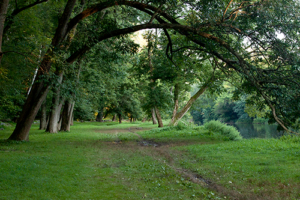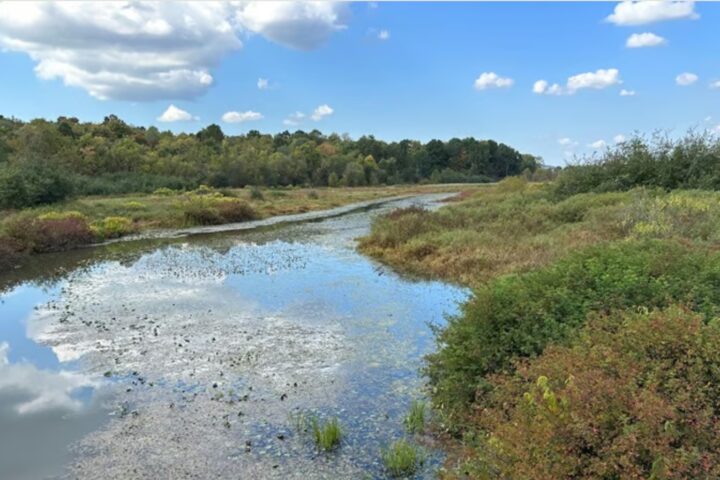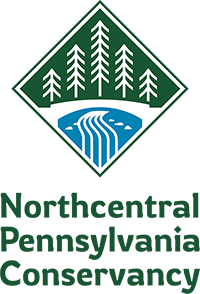
Photo by Whitney Flanagan
The Conservation Fund announced the addition of the 254-acre Beaver Valley property along Brandywine Creek to First State National Historical Park’s Brandywine Valley Unit. With private fundraising support from Mt. Cuba Center and others, The Conservation Fund was able to donate this land to the National Park Service (NPS) at no cost to the federal government.
In 2015, The Conservation Fund and other partners helped establish First State National Historical Park—the first national park for America’s first state. For the past four years, the beloved Beaver Valley tract, located adjacent to the 1,100-acre Brandywine Valley unit of the park, has been accessible to the public under The Conservation Fund’s ownership. Now the land is officially owned by the NPS and will remain protected and publicly accessible for hikers, bikers, horseback riders and runners throughout the region in perpetuity.
“We are thrilled to accept this land donation from The Conservation Fund,” said Cinda Waldbuesser, superintendent of First State National Historical Park. “The addition of this land to the park’s Brandywine Valley Unit adds many new miles of trail and bucolic landscapes for park visitors to enjoy.”
Prior to The Conservation Fund’s purchase, Beaver Valley was threatened by the development of 150 homes. A successful fundraising effort led by Mt. Cuba Center as well as the Beaver Valley Conservancy, Brandywine Conservancy, and Save the Valley, allowed The Conservation Fund to secure the site in 2017. During its ownership, the Fund worked with the National Park Foundation and private funders to renovate the buildings on the property and held the land until the NPS could formally accept the donation.
“People in the community have been enjoying the beauty of the Beaver Valley property for years, so it may come as a surprise that it wasn’t actually a part of the park until now,” said Blaine Phillips, Senior Vice President and Mid-Atlantic Regional Director at The Conservation Fund. “After securing the Brandywine Valley portion of First State several years ago, this addition has really been icing on the cake. We’re thrilled to have helped donate Beaver Valley to the national park so the local community and visiting tourists can continue to enjoy it for generations to come.”
“The environmental and historical significance of the Beaver Valley property make it a unique cultural resource that was on the verge of being lost forever,” said Mt. Cuba Center President, Ann C. Rose. “Integrating the Beaver Valley property into the First State National Historical Park realizes the original vision that inspired Mt. Cuba’s support for both of these important projects. Protecting large, contiguous natural areas conserves critical wildlife habitats, provides corridors that assist migratory species, improves water quality, and enhances ecological resilience to environmental stresses that are amplified by climate change.”
First State National Historical Park sits along the Delaware/Pennsylvania border in the Brandywine Valley—a place that represents the traditional homeland of the Lenni Lenape People and early American colonial history.
“The Lenape Indian Tribe of Delaware commends The Conservation Fund, Mt. Cuba Center and all their patrons for an outstanding job in preserving the Beaver Valley tract,” said Dennis ‘White Otter’ Coker, Principal Chief, Lenape Indian Tribe of Delaware. “Partnering with the First State National Historical Park to include this precious piece of Lenapehoking provides additional protections and accessibility for ‘All Our Relations’ to enjoy. Our Ancestors are singing and dancing in celebration of this achievement.”
The park also encompasses a bucolic landscape captured by Andrew Wyeth and a long tradition of artists and is rich in biodiversity. The Beaver Valley property itself supports upland forest, open meadows, and wetlands, as well as a wide variety of wildlife species including several that are endangered or species of concern.
“Adding this acreage to the national park not only provides more trails and outdoor recreation opportunities but finalizes the protection of a critical piece of the historic Brandywine Valley. As a new group that supports the park, we are honored to be part of this moment and to play a role in helping shape the future of First State National Historical Park,” said Richard Jones, Treasurer of Friends of First State.
Support from the National Park Foundation was essential for the stewardship and maintenance of Beaver Valley during The Conservation Fund’s ownership.
“Beaver Valley is a park landscape rich in opportunities for visitors to experience nature and explore history. From Native American culture, to Quaker farms, and miles of hiking and biking trails that connect people to the outdoors and our shared heritage,” said Will Shafroth, president and CEO of the National Park Foundation. “The National Park Foundation is dedicated to helping the National Park Service better accomplish its mission and is honored to support park partners in this collective effort to preserve and share the wonder of Beaver Valley, in perpetuity, within First State National Historical Park.”
Both the Pennsylvania and Delaware Congressional delegations played an integral role in establishing First State National Historical Park and supporting the Beaver Valley addition.
“The First State National Historical Park is an emblem of the Commonwealth’s natural splendor and biodiversity. The addition of this land to the park continues to build upon the natural resources of the Brandywine Valley in Southeastern Pennsylvania, a location with deep historical roots which reflects the unique history of America’s inception,” said U.S. Senator Bob Casey (PA).
“Adding Beaver Valley to the First State National Historical Park will help to protect more of Pennsylvania’s natural beauty,” said U.S. Senator Pat Toomey (PA). “The Conservation Fund’s efforts, in coordination with private partners, to preserve this land means the National Park Service will assume stewardship, helping it to be enjoyed by local residents and visitors for generations to come.”
“Our region has the exciting privilege to celebrate the addition of a beloved property to First State National Historical Park,” said Congresswoman Mary Gay Scanlon (PA-05). “Beaver Valley is a gem in our region, and I am thrilled that as part of a National Park Service site it will now remain protected and publicly accessible in perpetuity. The Conservation Fund, Mt. Cuba Center, and others who helped fundraise to keep this local treasure safe from development should be commended – it is because of their forward thinking and swift action that we are celebrating this addition to First State National Historical Park today.”
“The Brandywine River Valley, which flows through Delaware and Pennsylvania, is where America’s early commercial and agriculture foundation began, and for thousands of years prior, had been an important home to the Lenape. I am grateful to the National Park Service, The Conservation Fund, Mt. Cuba Center, Woodlawn Trustees, and many others who came together to preserve this significant land for generations past, present, and future,” said U.S. Senator Chris Coons (DE).
“First State National Historical Park has been a true blessing to the State of Delaware and the entire region. We’ve been so fortunate to celebrate the natural beauty and splendor of the First State through the park, and the addition of Beaver Valley will only add to its rich history and significance,” said Congresswoman Lisa Blunt Rochester (DE-00). “I want to thank The Conservation Fund, Mt. Cuba Center, and all the incredible partners who came together to make the expansion of the First State National Historical Park a reality.”
Located three miles north of Wilmington along the Brandywine River, First State National Historical Park has served as a wildlife preserve, urban park and recreation destination for the more than five million people who live within 25 miles. It provides a natural haven for many who may not have access to other nationally recognized parks in their area.
The Brandywine Unit of First State National Historical Park is one of six historic sites across both Delaware and Pennsylvania that tell the story of early settlement, and Delaware’s important role as the first state to ratify the Constitution. In 2013, President Obama designated the First State National Monument in Delaware, and after continuous conservation efforts and private fundraising, the monument was designated a National Historical Park in 2015.




